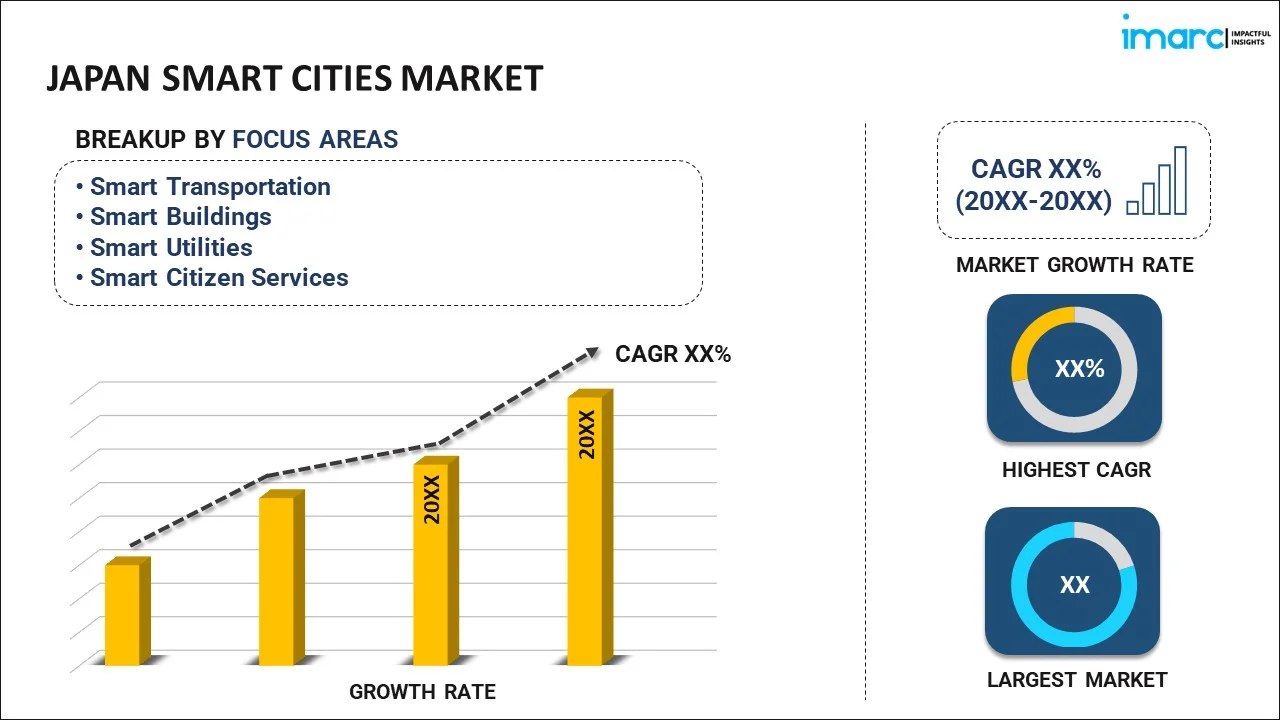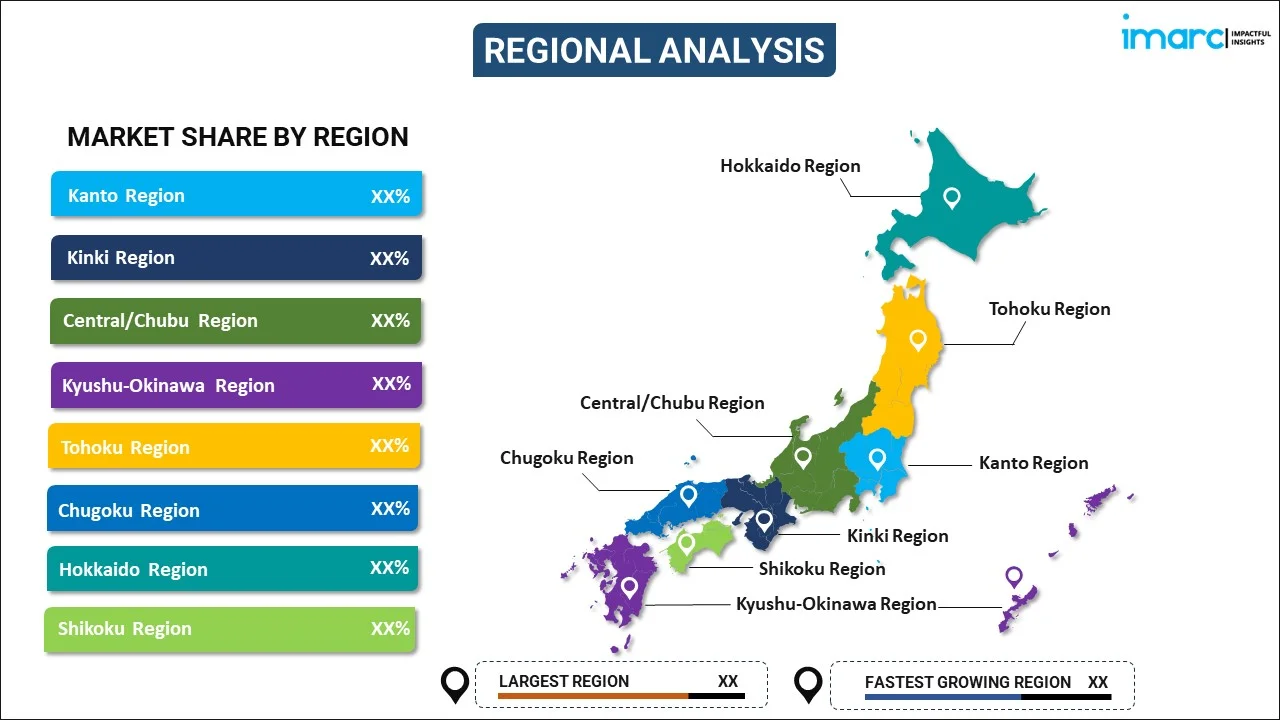
Japan Smart Cities Market Report by Focus Area (Smart Transportation, Smart Buildings, Smart Utilities, Smart Citizen Services), Smart Transportation (Smart Ticketing, Traffic Management System, Passenger Information Management System, Freight Information System, Connected Vehicles, and Others), Smart Buildings (Building Energy Optimization, Emergency Management System, Parking Management System, and Others), Smart Utilities (Advanced Metering Infrastructure, Distribution Management System, Substation Automation, and Others), Smart Citizen Services (Smart Education, Smart Healthcare, Smart Public Safety, Smart Street Lighting, and Others), and Region 2025-2033
Market Overview:
The Japan smart cities market size reached USD 84.1 Billion in 2024. Looking forward, IMARC Group expects the market to reach USD 286.6 Billion by 2033, exhibiting a growth rate (CAGR) of 14.6% during 2025-2033. The increasing commitment to environmental sustainability, rapid urbanization activities, recent technological advancements, imposition of supportive policies and regulations by the Government of Japan, and growing emphasis on enhancing public safety and security represent some of the key factors driving the market.
|
Report Attribute
|
Key Statistics
|
|---|---|
|
Base Year
|
2024 |
|
Forecast Years
|
2025-2033
|
|
Historical Years
|
2019-2024
|
| Market Size in 2024 | USD 84.1 Billion |
| Market Forecast in 2033 | USD 286.6 Billion |
| Market Growth Rate (2025-2033) | 14.6% |
Smart cities refer to urban areas that leverage digital technology, information, and communication systems to enhance the quality of life, efficiency of services, and economic prosperity. They comprise several components, such as intelligent transportation systems, smart energy grids, advanced sensors, and integrated communication networks. They offer numerous features, including real-time monitoring, analytics, automation, and seamless connectivity. Smart cities applications range from traffic management, waste control, energy efficiency, water supply management, healthcare services, education systems, crime prevention, disaster management, building management, public transportation, governance, tourism, environmental monitoring, agriculture, and e-governance. It aids in improving sustainability, conserving energy, reducing pollution, enhancing public safety, increasing accessibility, augmenting healthcare, providing higher education quality, and optimizing public services. Smart cities also facilitate rapid infrastructure development, economic growth, social integration, technological innovation, intelligent mobility, citizen empowerment, enhanced quality of life, and community development. They also provide several advantages, such as reduced costs, streamlined operations, agility in response to urban challenges, integrated management, adaptability to changing needs, strengthened resilience, collaboration between sectors, transparent governance, environmental stewardship, improved planning, better social cohesion, inclusiveness, and increased public engagement.
Japan Smart Cities Market Trends:
The Japan's commitment to environmental sustainability is facilitating the demand for smart cities, as they leverage green technologies to reduce carbon emissions, lower pollution levels, and minimize energy consumption. Additionally, the rapid urbanization in Japan's metropolitan areas, which necessitates efficient management of resources, including transportation, utilities, and public spaces, is boosting the market growth. Furthermore, the recent advancements in technology, including the Internet of Things (IoT) and artificial intelligence (AI), which facilitate the smart management of infrastructure, traffic, public safety and surveillance, healthcare, urban planning, and public services, are propelling the market growth. Besides this, the imposition of supportive policies and regulations by the Government of Japan to accelerate the development of smart cities to preserve the environment, improve public safety, and boost economic growth is strengthening the market growth. Apart from this, the growing emphasis on enhancing public safety and security through intelligent systems as they offer round-the-clock services, increase transparency, and eliminate human errors is acting as another growth-inducing factor. Moreover, the rising consumer awareness regarding energy efficiency and environmental conservation encouraging the adoption of smart city initiatives is catalyzing the market growth. In addition, the presence of an aging infrastructure across Japan, which demands modernization, is fueling the market growth. Along with this, the rising focus on improving transportation and traffic management to facilitate easy commutes and save time is positively impacting the market growth.
Japan Smart Cities Market Segmentation:
IMARC Group provides an analysis of the key trends in each segment of the Japan Smart cities market report, along with forecasts at the country level for 2025-2033. Our report has categorized the market based on focus area, smart transportation, smart buildings, smart utilities, and smart citizen services.
Focus Area Insights:

- Smart Transportation
- Smart Buildings
- Smart Utilities
- Smart Citizen Services
The report has provided a detailed breakup and analysis of the market based on the focus area. This includes smart transportation, smart buildings, smart utilities, and smart citizen services.
Smart Transportation Insights:
- Smart Ticketing
- Traffic Management System
- Passenger Information Management System
- Freight Information System
- Connected Vehicles
- Others
A detailed breakup and analysis of the market based on smart transportation has also been provided in the report. This includes smart ticketing, traffic management system, passenger information management system, freight information system, connected vehicles, and others.
Smart Buildings Insights:
- Building Energy Optimization
- Emergency Management System
- Parking Management System
- Others
A detailed breakup and analysis of the market based on the smart buildings has also been provided in the report. This includes building energy optimization, emergency management system, parking management system, and others.
Smart Utilities Insights:
- Advanced Metering Infrastructure
- Distribution Management System
- Substation Automation
- Others
A detailed breakup and analysis of the market based on the smart utilities has also been provided in the report. This includes advanced metering infrastructure, distribution management system, substation automation, and others.
Smart Citizen Services Insights:
- Smart Education
- Smart Healthcare
- Smart Public Safety
- Smart Street Lighting
- Others
A detailed breakup and analysis of the market based on the smart citizen services has also been provided in the report. This includes smart education, smart healthcare, smart public safety, smart street lighting, and others.
Regional Insights:

- Kanto Region
- Kinki Region
- Central/Chubu Region
- Kyushu-Okinawa Region
- Tohoku Region
- Chugoku Region
- Hokkaido Region
- Shikoku Region
The report has also provided a comprehensive analysis of all the major regional markets, which include Kanto Region, Kinki Region, Central/Chubu Region, Kyushu-Okinawa Region, Tohoku Region, Chugoku Region, Hokkaido Region, and Shikoku Region.
Competitive Landscape:
The report has also provided a comprehensive analysis of the competitive landscape in the market. Competitive analysis such as market structure, key player positioning, top winning strategies, competitive dashboard, and company evaluation quadrant has been covered in the report. Also, detailed profiles of all major companies have been provided.
Japan Smart Cities Market Report Coverage:
| Report Features | Details |
|---|---|
| Base Year of the Analysis | 2024 |
| Historical Period | 2019-2024 |
| Forecast Period | 2025-2033 |
| Units | Billion USD |
| Scope of the Report | Exploration of Historical and Forecast Trends, Industry Catalysts and Challenges, Segment-Wise Historical and Predictive Market Assessment:
|
| Focus Areas Covered | Smart Transportation, Smart Buildings, Smart Utilities, Smart Citizen Services |
| Smart Transportations Covered | Smart Ticketing, Traffic Management System, Passenger Information Management System, Freight Information System, Connected Vehicles, Others |
| Smart Buildings Covered | Building Energy Optimization, Emergency Management System, Parking Management System, Others |
| Smart Utilities Covered | Advanced Metering Infrastructure, Distribution Management System, Substation Automation, Others |
| Smart Citizen Services Covered | Smart Education, Smart Healthcare, Smart Public Safety, Smart Street Lighting, Others |
| Regions Covered | Kanto Region, Kinki Region, Central/Chubu Region, Kyushu-Okinawa Region, Tohoku Region, Chugoku Region, Hokkaido Region, Shikoku Region |
| Customization Scope | 10% Free Customization |
| Post-Sale Analyst Support | 10-12 Weeks |
| Delivery Format | PDF and Excel through Email (We can also provide the editable version of the report in PPT/Word format on special request) |
Key Questions Answered in This Report:
- How has the Japan Smart cities market performed so far and how will it perform in the coming years?
- What has been the impact of COVID-19 on the Japan Smart cities market?
- What is the breakup of the Japan Smart cities market on the basis of focus area?
- What is the breakup of the Japan Smart cities market on the basis of smart transportation?
- What is the breakup of the Japan Smart cities market on the basis of smart building?
- What is the breakup of the Japan Smart cities market on the basis of smart utilities?
- What is the breakup of the Japan Smart cities market on the basis of smart citizen services?
- What are the various stages in the value chain of the Japan Smart cities market?
- What are the key driving factors and challenges in the Japan Smart cities market?
- What is the structure of the Japan Smart cities market and who are the key players?
- What is the degree of competition in the Japan Smart cities market?
Key Benefits for Stakeholders:
- IMARC’s report offers a comprehensive quantitative analysis of various market segments, historical and current market trends, market forecasts, and dynamics of the Japan Smart cities market from 2019-2033.
- The research study provides the latest information on the market drivers, challenges, and opportunities in the Japan Smart cities market.
- Porter's five forces analysis assist stakeholders in assessing the impact of new entrants, competitive rivalry, supplier power, buyer power, and the threat of substitution. It helps stakeholders to analyze the level of competition within the Japan Smart cities industry and its attractiveness.
- Competitive landscape allows stakeholders to understand their competitive environment and provides an insight into the current positions of key players in the market.
Need more help?
- Speak to our experienced analysts for insights on the current market scenarios.
- Include additional segments and countries to customize the report as per your requirement.
- Gain an unparalleled competitive advantage in your domain by understanding how to utilize the report and positively impacting your operations and revenue.
- For further assistance, please connect with our analysts.
 Request Customization
Request Customization
 Speak to an Analyst
Speak to an Analyst
 Request Brochure
Request Brochure
 Inquire Before Buying
Inquire Before Buying




.webp)




.webp)












